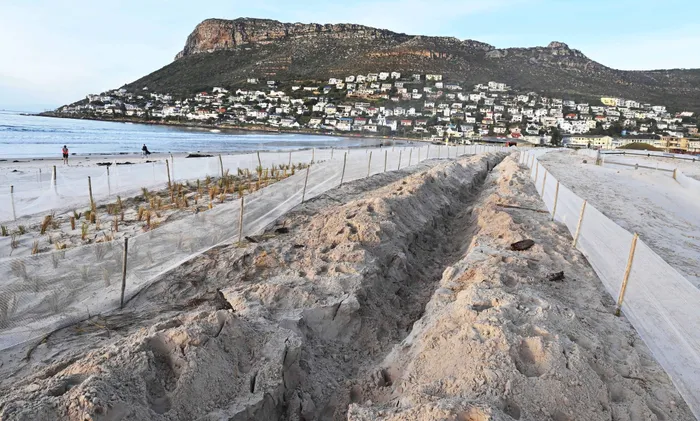Fish Hoek dune rehabilitation project ‘is making good progress’

Wind nets installed along Fish Hoek beach. The main objective of the Fish Hoek dune project is to re-profile the dunes by reducing the volume of sand to create a profile that is more typical of fore-dunes. Picture: City of Cape Town
Cape Town - The City of Cape Town said its Coastal Management team is making good progress with the re-profiling of the dunes along Fish Hoek beach.
Deputy mayor and Mayco member for spatial planning and environment Eddie Andrews visited the site on Thursday morning to monitor the progress.
This dune rehabilitation project will assist in trapping windblown sand, and in so doing, protect public and private infrastructure close to the beach.
Once the dunes have been established, residents should expect to see less sand smothering buildings, and on the roads and railway tracks.
The project is taking place along a stretch of 1.5km of coastline.
The main objective of the Fish Hoek dune project is to re-profile the dunes by reducing the volume of sand to create a profile that is more typical of fore-dunes.
None of the dunes at Fish Hoek or Glencairn are typical fore-dunes in that they are very narrow and steep, instead of having a broader base and lower or flatter profile.
Once re-profiled, the dunes will be revegetated with a diversity of coastally adapted plant species, similar to what has been successfully demonstrated at Hout Bay.

About 22 710 plants will be rescued from the dune system, and reused. All in all, around 82 670 plants will be planted.
Once the vegetation is established, it will be easier to maintain the dunes in the long term.
“At this stage, the earthworks of the Fish Hoek dune rehabilitation project is nearly complete and if all goes according to plan it is anticipated that the project should be fully implemented by July 2024,” Andrews said.
“It is important that we protect and manage these remaining dune systems as it plays a vital role in protecting the surrounding infrastructure from windblown sand. These systems will also buffer the Fish Hoek coastline against storm surge events and sea level rise.
“I am glad that our coastal management team has made good progress with this project despite the unseasonal south-easterly winds that we have experienced in May,” he said.
“We usually try to get as much done as possible during the winter months before the summer season’s strong winds arrive.
“Without intervention, the dunes and windblown sand will overwhelm the adjacent infrastructure, not only the railway line, but also roads and buildings,” said Andrews.

As a result of coastal processes, sand is deposited on the beach in winter and is transported landward by the prevailing south-easter in summer.
This sand used to be transported by the prevailing summer winds to Noordhoek.
This process still remains, but the sand can no longer move to Noordhoek and gets trapped within the narrow dune belt that now needs to be managed.
Over the next 12 months the City will be completing the following work along the beach:
- Re-profile and vegetate the dunes (stabilisation and rehabilitation of the dune cordon). More than 4.5 hectares of dune will be rehabilitated; 40 000m³ of sand will be moved and 9 570m³ of sand will be returned to the ocean for circulation.
- Install an irrigation system that will encourage vegetation establishment.
- Install dune nets to facilitate the stabilisation, trapping and placement of windblown sand within the dune area. About 6 500m of wind nets will be installed
- Restore coastal infrastructure: beach access, pathways and fencing.
- Beach cleaning: During the re-profiling of the dune system, organic material and other waste items that may be uncovered from the earthworks are collected daily during operations.

The Fish Hoek beachfront extends from the Galley restaurant in the south to Clovelly in the north-east.
This 1.5km stretch of coastline is not only a favourite recreation area and a prime tourist attraction, but also a popular whale-watching spot for local and international visitors during the spring months.
The Coastal Management Branch has taken the opportunity to include the Fish Hoek dune system in its dune management plan, along with Witsand, Kommetjie, Hout Bay, Table View and Gordon’s Bay.
The beach remains open to the public, but all are advised to avoid the areas where work is taking place, to keep dogs on a lead, and to only access the beach via designated access pathways.
Related Topics: